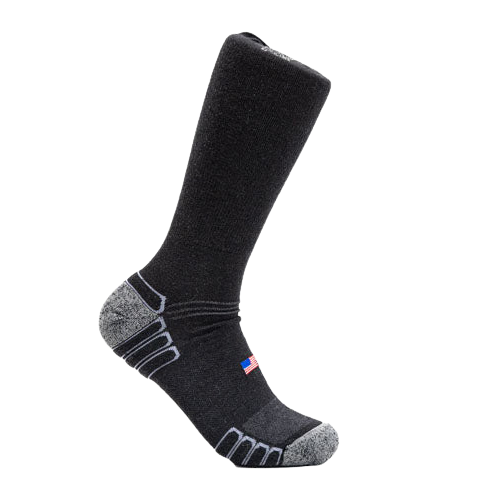Compression socks aren’t just tight to mess with your morning vibes.
They're special garments that gently squeeze your legs to boost blood flow and keep swelling in check. These snug-fitting socks apply pressure that's strongest at the ankle and gradually decreases up the leg, which helps push blood back to your heart.
Socks with compression socks can help with all sorts of leg issues. They're great for people who stand all day (looking at you, trade workers), athletes looking to recover faster, and folks dealing with vein problems. Plus, they can even help prevent blood clots on long flights. Not bad, eh?
What Are Compression Socks?

Compression socks are tight-fitting garments that apply pressure to your legs. They help improve blood flow and reduce swelling. Let's explore the different types and materials used to make these helpful socks.
Types of Compression Socks
Compression socks come in various styles to suit different needs. Knee-high compression socks like our Over the Calf Work Socks are the most common type. They cover your feet and calves, ending just below the knee.

Thigh-high socks extend to mid-thigh (our Boot Wool Work Socks would like a word), offering more coverage. For full-leg compression, there are waist-high options out there too.

Some socks have open toes, which can be comfy in warm weather. Others have special padding for extra comfort.
Compression levels vary too. Mild compression is great for everyday wear (Camel City Mill Work Socks are mild compression). Stronger compression is used for medical reasons.
Common Materials Used
Compression socks are made from a mix of materials. This blend helps them stretch and bounce back to their original shape.
Nylon and spandex are common ingredients, and that’s what we use. They make the socks stretchy and durable.
Some socks use cotton for comfort and breathability. Microfiber is another option that wicks away sweat.
If you have sensitive skin, you can find socks made with natural fibers like merino wool (we also use merino wool).
Special materials like silver or copper are sometimes added. These can help fight odors and bacteria.
The Mechanics of Compression Therapy
Compression therapy uses pressure to improve blood flow in the legs. Here’s how this pressure is applied and the different levels used.

Graduated Compression
Compression socks use graduated pressure to help blood flow. They're tightest at the ankle and get looser as they go up the leg. This design pushes blood upward toward the heart.
The pressure from the socks squeezes the leg veins. This makes them narrower and forces blood to move faster. It's like squeezing a garden hose - the water comes out faster.
Graduated compression also helps reduce swelling. It stops fluid from building up in the tissues of the lower leg. This can make your legs feel less heavy and achy.
Levels of Compression
Compression socks come in different strengths. The pressure is measured in millimeters of mercury (mmHg). Here are the main levels:
-
Mild (8-15 mmHg): For everyday wear and long flights (our socks)
-
Medium (15-20 mmHg): For minor swelling and varicose veins
-
Firm (20-30 mmHg): For more serious vein issues
-
Extra Firm (30-40 mmHg): For severe vein problems
The right level depends on your needs. Mild compression is good for tired legs. Stronger compression helps with more serious conditions like deep vein thrombosis.
We always suggest talking to a doctor before using high-pressure socks. They can help pick the right level for you.
3 Benefits of Wearing Compression Socks

Compression socks offer many perks for our legs and feet. We've found they can boost blood flow, ease swelling, and help with vein problems. Let's look at how these snug socks can make our legs feel better.
Improved Circulation
Compression stockings help improve our blood flow. They gently squeeze our legs, which pushes blood back up to our heart. This is great for trade workers who work 14+ hour shifts and/or sit or stand a lot during the day.
Better blood flow means:
-
Less risk of blood clots
-
More oxygen to our muscles
-
Quicker recovery after exercise
We've noticed our legs feel less tired when we wear these socks. It's like they give our veins a helping hand to do their job better.
Reduction of Swelling and Fatigue
Compression socks can make our legs feel less puffy and tired. They work by:
-
Pressing on our leg tissues and veins
-
Helping fluid move out of our legs
-
Reducing the heavy feeling we sometimes get
These socks can decrease swelling, which is great for long flights or if we're on our feet all day. We've found our ankles don't puff up as much when we wear them.
For athletes, these socks can mean less muscle soreness after a workout. They help clear out lactic acid faster, so we recover quicker.
Support for Varicose Veins
Varicose veins can be painful and unsightly. Compression socks can help by:
-
Easing pressure in our veins
-
Improving blood flow in problem areas
-
Reducing aching and heaviness
We've seen that wearing these socks can make varicose veins less noticeable over time. They support our leg veins and help prevent new varicose veins from forming.
These stockings are often recommended for people with vein issues. They're a simple way to ease discomfort without surgery or medications.
For best results, we should put them on in the morning before our legs start to swell. It's an easy step that can make a big difference in how our legs feel all day.
Proper Use and Care

Wearing and caring for compression socks correctly is key to getting the most benefit. Let's look at how to put them on, when to wear them, and how to keep them in good shape.
How to Wear Them
Putting on compression socks takes a bit of practice. First, turn the sock inside out to the heel. Slip your foot in and pull the sock up to your ankle. Then, gently roll and unroll the sock up your leg.
Smooth out any wrinkles as you go. This helps the sock work right and stops skin issues. Don't roll the top down - it can cut off blood flow.
If you have trouble, try these tips:
-
Use talcum powder on your legs
-
Wear rubber gloves for a better grip
-
Use a sock aid if bending is hard
When to Wear Them
We should put on compression socks first thing in the morning. Our legs are least swollen then. Wear them all day and take them off before bed.
For travel, put them on before your trip starts. Keep them on until you can walk around freely. If you sit a lot at work, wear them during your shift.
Compression socks help with many leg issues. But always check with a doctor about how long to wear them. Some people might need them only for certain times or activities.
Maintaining Your Compression Socks
Good care makes compression socks last longer. Wash them after each use. Use cool water and mild soap. Don't use bleach or fabric softener. These can harm the elastic.
Hand washing is best, but gentle machine wash works too. Hang to dry - don't use the dryer. Heat can damage the fibers.
Replace your socks every 3-6 months. They lose pressure over time. Check for signs of wear like:
-
Loose elastic
-
Thin spots
-
Runs or holes
Alternatively, opt for higher quality socks from the outset that don’t need replacing as often. We’re so confident in the durability of our socks that we offer a 10-year Durability Guarantee.
Store them flat or gently rolled. Don't fold them - it can weaken the fabric.
Check out our Work Socks now for the ideal blend of compression and comfort.






